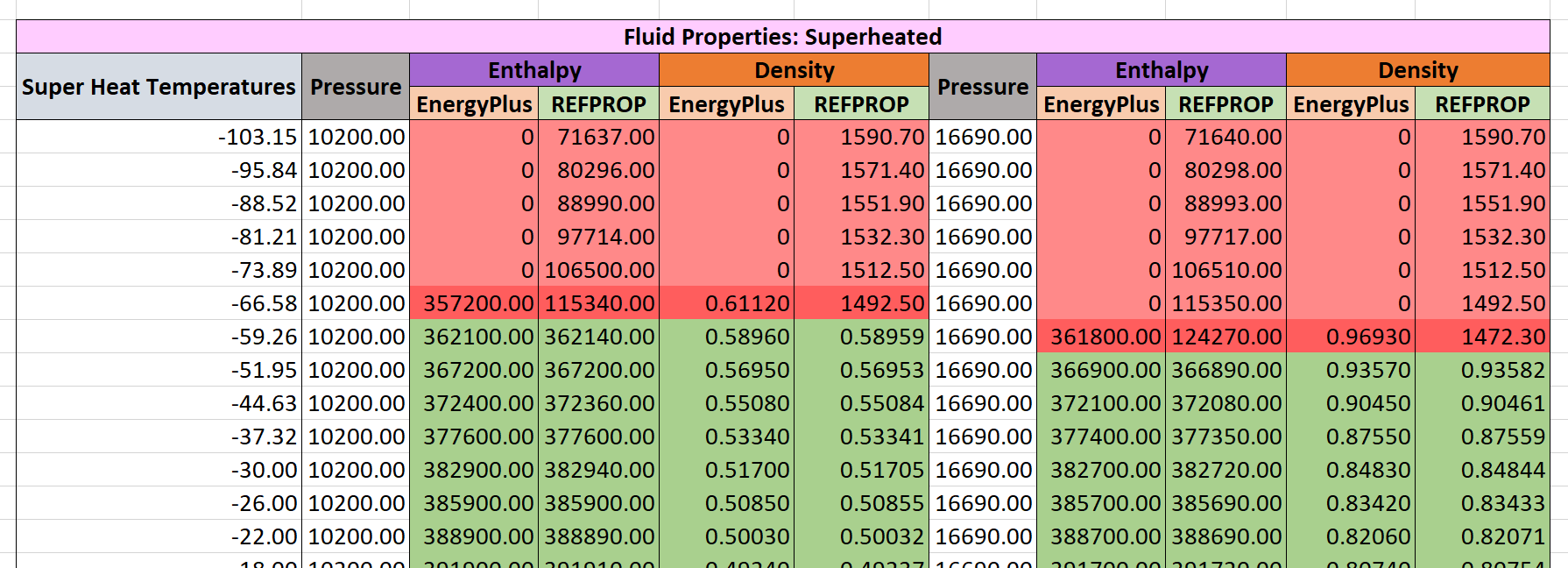First time here? Check out the Help page!
 | 1 | initial version |
@Ericringold, thank you for your valuable insights. Could you provide guidance on generating thermodynamic properties for superheated temperatures, or share any relevant information that might assist in this process?
In my exploration of REFPROP's functionality, I've compared the properties of R-134a as generated by REFPROP with those available in the EnergyPlus dataset. Saturated properties align closely, as illustrated in the accompanying figure below.

However, anomalies appear in the superheat data. I selected two pressure values and compared the fluid property data generated by REFPROP with that of EnergyPlus for these pressure values. The figure below illustrates enthalpy and density in the superheat range. Notably, for P= 10200 Pa, all five initial values are zero in the EnergyPlus data set, whereas REFPROP generates non-zero data. However, from the sixth value onwards (7 onwards), the data generated is closely aligned with that of EnergyPlus.

 | 2 | No.2 Revision |
@Ericringold, thank you for your valuable insights. Could you provide guidance on generating thermodynamic properties for superheated temperatures, or share any relevant information that might assist in this process?generating refrigeration properties for EnergyPlus?
In my exploration of REFPROP's functionality, I've compared the properties of R-134a as generated by REFPROP with those available in the EnergyPlus dataset. Saturated properties align closely, as illustrated in the accompanying figure below.

However, anomalies appear in the superheat data. I selected two pressure values and compared the fluid property data generated by REFPROP with that of EnergyPlus for these pressure values. The figure below illustrates enthalpy and density in the superheat range. Notably, for P= 10200 Pa, all five initial values are zero in the EnergyPlus data set, whereas REFPROP generates non-zero data. However, from the sixth value onwards (7 onwards), the data generated is closely aligned with that of EnergyPlus.

 | 3 | No.3 Revision |
@Ericringold, thank you for your valuable insights. Could you provide guidance on generating thermodynamic properties for superheated temperatures, or share any relevant information that might assist in generating refrigeration properties for EnergyPlus?
In my exploration of REFPROP's functionality, I've compared the properties of R-134a as generated by REFPROP with those available in the EnergyPlus dataset. Saturated properties align closely, as illustrated in the accompanying figure below.

However, anomalies appear in the superheat data. I selected two pressure values and compared the fluid property data generated by REFPROP with that of EnergyPlus for these pressure values. The figure below illustrates enthalpy and density in the superheat range. Notably, for P= 10200 Pa, all five initial values are zero in the EnergyPlus data set, whereas REFPROP generates non-zero data. However, from the sixth value onwards (7 onwards), the data generated is closely aligned with that of EnergyPlus.


 | 4 | No.4 Revision |
@Ericringold, thank you for your valuable insights. Could you provide guidance on generating thermodynamic properties for superheated temperatures, or share any relevant information that might assist in generating refrigeration properties for EnergyPlus?
In my exploration of REFPROP's functionality, I've compared the properties of R-134a as generated by REFPROP with those available in the EnergyPlus dataset. Saturated properties align closely, as illustrated in the accompanying figure below.

However, anomalies appear in the superheat data. I selected two pressure values and compared the fluid property data generated by REFPROP with that of EnergyPlus for these pressure values. The figure below illustrates enthalpy and density in the superheat range. Notably, for P= 10200 Pa, all five initial values are zero in the EnergyPlus data set, whereas REFPROP generates non-zero data. However, from the sixth value onwards (7 onwards), the data generated is closely aligned with that of EnergyPlus.

Updated Answer:
I have used DaikkinRef v.11.3 tool developed by DAIKIN Chemical Europe GmbH to get R-455A thermodynamic properties.
For the non-null values in data calculated by REFPROP, the tool calculates properties, and they might be out or in the superheated area, and I have understood that EnergyPlus is only interested in the superheated area, so it assigns null values for the properties that are out of the superheated area.
For the non-null values in the REFPROP data, the tool determines properties that could fall within or outside the superheated region. I've learned that EnergyPlus solely focuses on the superheated region; thus, it assigns properties outside this region as zero.
 | 5 | No.5 Revision |
@Ericringold, thank you for your valuable insights. Could you provide guidance on generating thermodynamic properties for superheated temperatures, or share any relevant information that might assist in generating refrigeration properties for EnergyPlus?
In my exploration of REFPROP's functionality, I've compared the properties of R-134a as generated by REFPROP with those available in the EnergyPlus dataset. Saturated properties align closely, as illustrated in the accompanying figure below.

However, anomalies appear in the superheat data. I selected two pressure values and compared the fluid property data generated by REFPROP with that of EnergyPlus for these pressure values. The figure below illustrates enthalpy and density in the superheat range. Notably, for P= 10200 Pa, all five initial values are zero in the EnergyPlus data set, whereas REFPROP generates non-zero data. However, from the sixth value onwards (7 onwards), the data generated is closely aligned with that of EnergyPlus.

Updated Answer:
I have used DaikkinRef v.11.3 tool developed by DAIKIN Chemical Europe GmbH to get R-455A thermodynamic properties.
For the non-null values in data calculated by REFPROP, the tool calculates properties, and they might be out or in the superheated area, and I have understood that EnergyPlus is only interested in the superheated area, so it assigns null values for the properties that are out of the superheated area.
For the non-null values in the REFPROP data, the tool determines properties that could fall within or outside the superheated region. I've learned that EnergyPlus solely focuses on the superheated region; thus, it assigns properties outside this region as zero.
